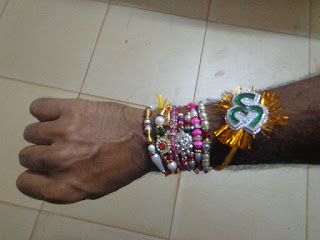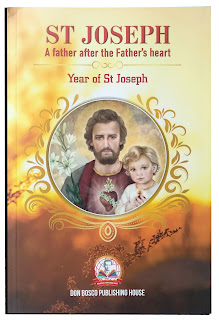Raksha Bandhan: Heart Strings or Locked Doors?
Raksha Bandhan is a yearly feast that many young girls and
boys look forward to. The boys look forward to it more than the girls for
reasons I will mention a little later. This is a typically Indian feast which
celebrates familial ties between brothers and sisters. The words ‘Raksha
Bandhan’ mean quite literally ‘Bond of Protection’. The festive celebration
centres around the sister tying a ‘rakhi’, which is a decorative thread adorned
with beads and other trinkets, on the hand of her brother.
This is an ancient Hindu festival that ritually celebrates
the love and duty between brothers and their sisters. The sister performs
a Rakhi ceremony, then prays to express her love and her wish for the
well being of her brother; in return, the brother ritually pledges to protect
and take care of his sister under all circumstances. It is one of the several
occasions in which family ties are affirmed in India. The tying of the rakhi is
preceded by the performance of aarti and the recitation of prayers primarily
gleaned from the Hindu scriptures. The festival is also an occasion to
celebrate brother-sister like family ties between cousins or distant family
members, sometimes between biologically unrelated men and women. To many,
the festival transcends biological family, brings together men and women across
religions, diverse ethnic groups and ritually emphasizes harmony and love. It
is observed in the Hindu calendar month of Śrāvaṇa, and
typically falls in August every year.
I had mentioned earlier that this is one feast that is eagerly
anticipated especially by the younger generation. The reason I realize is not
so much for the religiosity as much as for the social and peer pressure. I
remember my days in school when all of us guys would dread the day of Raksha
Bandhan. We would all huddle together and try to avoid allowing the girl of our
wishes and dreams from tying a rakhi around our wrist. Tying of the rakhi was
considered to be a shortening of our girl-shortlist. For girls it was an
opportunity to reduce the number of boys pursuing them. Hence, the feast had
lost its significance and taken on a new, unthinkable and probably base
meaning. Any girl coming forward to tie a rakhi was looked upon with suspicion
and so was any boy who went out of his way to avoid getting a rakhi tied.
This raised up the question in my mind: Are the Rakhis a
symbol of heart strings, which stand for genuine love, concern, care and
protection or are they a symbol of a locked door, telling a boy to give up any
‘other’ ideas he may have? From my experience, I find it difficult to say,
because sometimes it is used as a heart string and at another time it is used
as a locked door. This year I had the privilege of getting a number of girls
tying rakhis on my wrist. I ended up having more rakhis on this day than I had
got in all of my previous years put together. With each rakhi that was tied I
reminded myself of my growing responsibility. I felt humbled that so many girls
found in me someone they can rely on and come to in times of need. For me, this
Raksha Bandhan was an experience of having heart strings tied around my wrist
and strengthening bonds of friendship. Never before did I feel so important and
revered. The spirit with which the rakhis were tied really made me feel that
the feast was celebrated in its true nature.
Indian culture is really fantastic but unfortunately we have
let go of the spirit of the festivals and have caught on to the peripherals. We
have made the celebrations so great that they obliterate the true and core
meaning of what the festival is celebrating. Fortunately there are some who
still value the festivals for what they are and celebrate them fittingly. Raksha
Bandhan is definitely a celebration of heart strings and not locked doors; it
strengthens and reaffirms familial bonds and unites the community. If
celebrated in a proper spirit it can help eradicate the ills faced by the
girl-child in India and can even build up the country and help it achieve its
potential. For in unity lies strength.




Well said Ian.
ReplyDelete